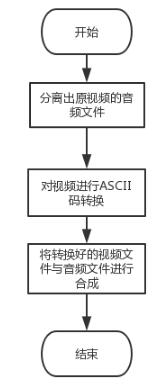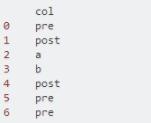python如何实现视频转代码视频
本文实例为大家分享了python如何实现视频转代码视频的具体代码,供大家参考,具体内容如下
# -*- coding:utf-8 -*-
#coding:utf-8
import argparse
import os
import cv2
import subprocess
from cv2 import VideoWriter, VideoWriter_fourcc, imread, resize
from PIL import Image, ImageFont, ImageDraw
# 命令行输入参数处理
# aparser = argparse.ArgumentParser()
# aparser.add_argument('file')
# aparser.add_argument('-o','--output')
# aparser.add_argument('-f','--fps',type = float, default = 24)#帧
# aparser.add_argument('-s','--save',type = bool, nargs='?', default = False, const = True)
# 是否保留Cache文件,默认不保存
# 获取参数
# args = parser.parse_args()
# INPUT = args.file
# OUTPUT = args.output
# SAVE = args.save
# FPS = args.fps
# 像素对应ascii码
ascii_char = list("$@B%8&WM#*oahkbdpqwmZO0QLCJUYXzcvunxrjft/\|()1{}[]?-_+~<>i!lI;:oa+>!:+. ")
# ascii_char = list("MNHQ$OC67+>!:-. ")
# ascii_char = list("MNHQ$OC67)oa+>!:+. ")
# 将像素转换为ascii码
def get_char(r, g, b, alpha=256):
if alpha == 0:
return ''
length = len(ascii_char)
gray = int(0.2126 * r + 0.7152 * g + 0.0722 * b)
unit = (256.0 + 1) / length
return ascii_char[int(gray / unit)]
# 将txt转换为图片
def txt2image(file_name):
im = Image.open(file_name).convert('RGB')
# gif拆分后的图像,需要转换,否则报错,由于gif分割后保存的是索引颜色
raw_width = im.width
raw_height = im.height
width = int(raw_width / 6)
height = int(raw_height / 15)
im = im.resize((width, height), Image.NEAREST)
txt = ""
colors = []
for i in range(height):
for j in range(width):
pixel = im.getpixel((j, i))
colors.append((pixel[0], pixel[1], pixel[2]))
if (len(pixel) == 4):
txt += get_char(pixel[0], pixel[1], pixel[2], pixel[3])
else:
txt += get_char(pixel[0], pixel[1], pixel[2])
txt += '\n'
colors.append((255, 255, 255))
im_txt = Image.new("RGB", (raw_width, raw_height), (255, 255, 255))
dr = ImageDraw.Draw(im_txt)
# font = ImageFont.truetype(os.path.join("fonts","汉仪楷体简.ttf"),18)
font = ImageFont.load_default().font
x = y = 0
# 获取字体的宽高
font_w, font_h = font.getsize(txt[1])
font_h *= 1.37 # 调整后更佳
# ImageDraw为每个ascii码进行上色
for i in range(len(txt)):
if (txt[i] == '\n'):
x += font_h
y = -font_w
# self, xy, text, fill = None, font = None, anchor = None,
#*args, ** kwargs
dr.text((y, x), txt[i], fill=colors[i])
#dr.text((y, x), txt[i], font=font, fill=colors[i])
y += font_w
name = file_name
#print(name + ' changed')
im_txt.save(name)
# 将视频拆分成图片
def video2txt_jpg(file_name):
vc = cv2.VideoCapture(file_name)
c = 1
if vc.isOpened():
r, frame = vc.read()
if not os.path.exists('Cache'):
os.mkdir('Cache')
os.chdir('Cache')
else:
r = False
while r:
cv2.imwrite(str(c) + '.jpg', frame)
txt2image(str(c) + '.jpg') # 同时转换为ascii图
r, frame = vc.read()
c += 1
os.chdir('..')
return vc
# 将图片合成视频
def jpg2video(outfile_name, fps):
fourcc = VideoWriter_fourcc(*"MJPG")
images = os.listdir('Cache')
im = Image.open('Cache/' + images[0])
vw = cv2.VideoWriter(outfile_name + '.avi', fourcc, fps, im.size)
os.chdir('Cache')
for image in range(len(images)):
# Image.open(str(image)+'.jpg').convert("RGB").save(str(image)+'.jpg')
frame = cv2.imread(str(image + 1) + '.jpg')
vw.write(frame)
#print(str(image + 1) + '.jpg' + ' finished')
os.chdir('..')
vw.release()
# 递归删除目录
def remove_dir(path):
if os.path.exists(path):
if os.path.isdir(path):
dirs = os.listdir(path)
for d in dirs:
if os.path.isdir(path + '/' + d):
remove_dir(path + '/' + d)
elif os.path.isfile(path + '/' + d):
os.remove(path + '/' + d)
os.rmdir(path)
return
elif os.path.isfile(path):
os.remove(path)
return
# 调用ffmpeg获取mp3音频文件
def video2mp3(file_name):
outfile_name = file_name.split('.')[0] + '.mp3'
subprocess.call('ffmpeg -i ' + file_name + ' -f mp3 ' + outfile_name, shell=True)
# 合成音频和视频文件
def video_add_mp3(file_name, mp3_file):
outfile_name = file_name.split('.')[0] + '-txt.mp4'
subprocess.call('ffmpeg -i ' + file_name + ' -i ' + mp3_file + ' -strict -2 -f mp4 ' + outfile_name, shell=True)
if __name__ == '__main__':
INPUT = r"G:\py\学习python\视频到代码\video39.mp4"
OUTPUT = r"G:\py\学习python\视频到代码\video39_2.mp4"
SAVE = r"G:\py\学习python\视频到代码\\video39_3"
FPS = "24"
vc = video2txt_jpg(INPUT)
FPS = vc.get(cv2.CAP_PROP_FPS) # 获取帧率
print(FPS)
vc.release()
jpg2video(INPUT.split('.')[0], FPS)
print(INPUT, INPUT.split('.')[0] + '.mp3')
video2mp3(INPUT)
video_add_mp3(INPUT.split('.')[0] + '.avi', INPUT.split('.')[0] + '.mp3')
if (not SAVE):
remove_dir("Cache")
os.remove(INPUT.split('.')[0] + '.mp3')
os.remove(INPUT.split('.')[0] + '.avi')
流程图:
这次python编程的流程图如下:

注意事项:
在编程的过程中有需要注意的几点:
- 这次编程使用到了opencv库,需要安装
- 帧率的获取可以通过这个函数——FPS = vc.get(cv2.CAP_PROP_FPS)
- 合成后的视频是没有声音的,我们使用ffmpeg进行合成
以上就是本文的全部内容,希望对大家的学习有所帮助,也希望大家多多支持【听图阁-专注于Python设计】。


